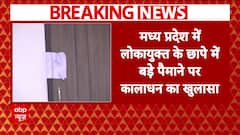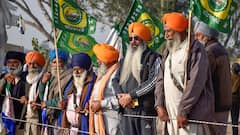Poila Boishakh 1429 | Covid, Cyclone, Computer: The Timeless Haal Khata May Be A Closed Book Soon
Haal khata or kheror khata is a ledger book used by traders to note down their transactions. But on Bengali New Year, it assumes a lot of significance for traders and is considered auspicious.

Kolkata: If you visit any old business establishment on Poila Boishakh, or the Bengali New Year, in West Bengal, it will be hard for you not to notice a red-cloth-hand-bound notebook near the billing desk.
Known as haal khata or kheror khata, it is basically a ledger book used by traders to note down their transactions. But on Bengali New Year, it assumes a lot of significance for traders and is considered auspicious.
Earlier, even 8-10 years ago, the "haal khata tradition" used to be a ceremony in itself, but now digitisation has turned it into a mere formality.
Pandemic Blues
Apart from depleting sales due to low demand, the Covid-19 pandemic and rise in cost of paper has come as a double whammy to the haal khata manufacturers in Kolkata's Baithakkhana bazaar, one of India's largest paper markets.
"Covid-19 has affected us a lot, business has been close to nil in the last two years. This year, there has been a little improvement. Earlier, kheror khata used to sell like hot cakes but today even 10 per cent of that quantity is not sold," said Mohammad Farooq of Bichitra Stores.

Md Farooq, whose shop is over 30 years old, said even small traders nowadays prefer to maintain their accounts in excel files rather than ledger books.
"Two years ago, sales were around Rs 10-15 lakh. It has dipped to just Rs 2 lakh. Haal khata used to be a festival in itself, now it is just used for puja purposes on Poila Baisakh," he rued.
Business On Last Legs?
The 'haal khata' ceremony begins early in the day, with shopkeepers and traders, decked in dhoti and kurta, praying to God and seeking blessings for their new ledger books. Some even invite priests to their offices for rituals and a puja is conducted with new idols of Lord Ganesha and Goddess Laxmi.
In the evening, the shopkeepers invite their stakeholders and loyal customers and give them sweet packets. Most of the establishments remain choc-a-bloc on this day as people throng their favourite shops with much enthusiasm.
While these red-cover books are still part of the Poila Baisakh ritual in most shops in Kolkata, the manufacturers of these haal khatas admit the business is on its last legs.
The effect was visible on College Street, the largest book market in Asia and the largest second-hand book market in the world. The soft, handstiched kheror khata could not be found in any of the shops while a few sold the hardbound ones.
"Earlier, College Street used to be a sea of red in the days running up to Poila Baisakh as many shops used to stock up on haal khata. Now, the demand has reduced drastically," said Imran of Bichitra Paperworks.
While sales of haal khata have been on the decline in the past few years, the Covid-19 pandemic has nearly finished the business, manufacturers said.
"Covid has nearly finished those dealing in paper products. Moreover, due to schools and colleges being closed, the market faced huge losses," Imran said.

Loss Of Skilled Labourers
Another major problem faced by these manufacturers was the loss of skilled labour following the lockdown. While many may not know, the haal khata used for pujas in shops by traders are made by Muslim workers.
Imran said with the sharp decline in binding work, many have ventured into other trades. "Some are doing digging work, some have enrolled for NREGA for 100 days' work, while some have taken to farming. Most have gone outside Bengal and have settled in Andhra Pradesh, Kerala, Tamil Nadu," he said.
Mohammad Rahim, who works with Nitai Shah & Sons, the largest manufacturer of haal khata in Baithakkhana bazaar, said they paid the pending wages to their labourers and asked them to leave after lockdown was announced.
"Earlier, 17-18 people used to work, now only five people are here," Rahim said while pointing at a huge kadhai that was used to cook food for the labourers before Covid-19 struck.
Rahim, who has been working at Nitai Shah for more than 50 years, said kheror khata worth Rs 15,000-20,000 used to be sold per day ahead of Poila Baisakh before the pandemic. "Now, it's not even 20 per cent of that," he said.
However, Mohammed Farooq of Bichitra Stores said most of his workers had returned. "Due to the sudden lockdown (announced in April 2020), 15 of my labourers had been stuck for three months. I supplied them with food from my own pocket despite no sales. They left then, but have come back now," he said.
Double Whammy Of Rising Paper Costs, Cyclone Amphan
The spike in the rate of paper and raw materials like canvas and transportation cost due to rise in fuel prices have compounded the situation even further for haal khata manufacturers.
"The cost to make a haal khata has now doubled from what it used to be two years before. The cost of paper has increased by 40 per cent this year," Farooq said.
Farooq, whose factory is in Khardah (about 16 km from Kolkata), said this year he had to sell the ledger books keeping a low profit margin as transportation costs have also increased due to a steep hike in fuel prices.
Echoing him, Rahim said one haal khata, which used to be sold for Rs 45 in 2020, now costs around Rs 100.
Another manufacturer, Goutam Saha, proprietor of Narayan Chandra Saha Paperworks, said due to the rise in costs, shopkeepers were reluctant to buy kheror khata fearing that they would not sell.
"The cost of one ream of paper has increased by Rs 200-250. Rise in paper costs have hit us this year after the second wave and Omicron wave in 2021 led to a sharp dip in sales in Poila Baisakh and Akshaya Tritiya respectively," Goutam Saha said.

Most of the manufacturers said they were still repaying the loans they had taken following the losses they suffered during Cyclone Amphan, which struck Bengal in 2020.
"More than Covid, what has broken our backs is the Amphan cyclone. Since the lockdown was announced suddenly, we could not shift our products and went to our native village. After Amphan struck, I cycled for more than 20 km to reach my shop only to find the items floating in water," Goutam Saha said.
Saha said he incurred losses of about Rs 2-2.5 lakh that year. "Small businesses like ours take money from mahajans and we clear the debt around Poila Boisakh. I have not been able to repay that yet," a dejected Saha said.
Making A Kheror Khata
Making a haal khata is a cumbersome and painstaking job since it is fully handmade. Due to the dip in demand, work to produce haal khata now begins from February and continues till April 14. Earlier, work used to start from December, said Rahim.
The red rough cotton material used as the cover for these books is called "khero", hence the name kheror khata. Some manufacturers use the cheaper lal shalu material as well.

There are four types of haal khata available depending on their sizes — jabeda khata, dak khata, khana khata and khotiyan khata (not made now).
Explaining the process in making a kheror khata, Rahim said, "First the red cloth material is cut and glued to fims of canvas of the same size. These are then hung in the ropes outside to dry. The books are then stitched using a thread and a twine is used to tie the books."
The 60-year-old Rahim, who hails from Joynagar, has been involved in making kheror khata since he was 13 years old. He said the khero cloth comes from Mumbai and they buy it from Burrabazar wholesale market.
According to Rahim, kheror khata was basically used by people from East Pakistan. After Bangladesh separated from India, some people continued the business here after learning the craft from them.
However, the use of haal khata by traders dates back to the 18th century even though there is no exact account when this practice started. During the Zamindari system, the ledger book was updated on this day and creditors paid off.
Some reports also say that it was Mughal Emperor Akbar who first introduced this practice in 1556 to align the tax collection process with the harvest season. The Islamic lunar calendar apparently did not match the agricultural cycles.
While the tradition of haal khata has survived the test of time in Bengal, it may be a closed book in the years to come as the business community embraces digitisation.
Trending News
Top Headlines






































